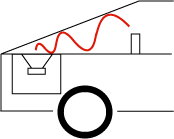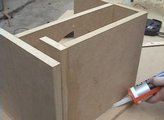The Effects of Cabin Gain in Car Audio
Have you ever wondered why car audio systems can have so much bass as compared to a home stereo system? The reason has to do with space. Your home has a lot of it and your car doesn't. Because there is so little space in a car the bass notes (which are long pressure waves) build up inside the passenger area. To calculate the length of a sound wave you divide the speed of sound (in feet per second) by the frequency. At sea level, the speed of sound is approximately 1,127 ft/sec. For example, a 40 Hz note has a wavelength of approximately 28 ft (at sea level).
(speed of sound)/(frequency) = wavelength
OR
(1,127 ft/sec)/(40Hz) = 28.175 ft
Since the length of the average car interior (including trunk) is in the 12 ft range the 40 Hz note will be longer then the car's interior. This is why notes below 70-90 Hz (depending on the vehicle) will have a greater output than the rest of the frequencies. Once this magic frequency is reached, bass output will increase by about 12 dB/octave below that frequency. This phenomenon is called cabin gain or the "transfer function". So a smaller vehicle will have a greater cabin gain and should be able to have greater low bass than a larger vehicle. This is true for identical subwoofer systems with identical power. However larger vehicles are able to fit more subwoofers and amplifiers and so can out produce a smaller vehicle with limited space.
The transfer function works well because human ears are less sensitive to low bass. This natural bass boost helps to compensate for this. It doesn't matter what type of vehicle you have, the cabin gain will still apply. It will just be at a lower frequency with larger vehicles and at a higher frequency with smaller vehicles. Firing orientation of the subwoofer system has no effect on the transfer function of a particular vehicle. You can face the woofers in any direction or place them anywhere in the vehicle and the gain will be the same because it is only dependent on vehicle size. This is not to say that firing orientation or woofer placement will not have an effect on the subwoofer system output. It certainly does but this difference is not attributable to the cabin gain.
Up Front Bass
Another happy side effect is that we are not able to tell where the subwoofer is placed in the vehicle. Basically what happens is that below this magic, vehicle dependent, frequency the subwoofer is simply pressurizing the air in the vehicle and no longer becomes an identifiable point source. This allows placement of the subwoofer in the trunk and still have the impression that the bass is in front of us, commonly called "up front bass". This is often more difficult to achieve in practice and requires careful selection of crossover frequencies and high subwoofer crossover slopes. If the slope is not high enough or the subwoofer crossover point is not low enough then we will hear mid-bass frequencies coming from the rear of the car and will be able to localize the subwoofer system. Any rattles that come from the trunk area will also ruin the effect. This is where proper use of damping materials comes into play.
Maximizing the Output of Your Subwoofer Through Proper Placement
Choosing the right subwoofer with the right enclosure and the proper amount of power is only half the battle in achieving maximum bass. You also need to properly position the subwoofer in the vehicle. If you've been into car audio long enough you'll learn that an enclosure will sound louder in different parts of the vehicle. Common sense would tell you that you should get the enclosure as close as possible to the passengers. Actually this is not always correct. Most enclosures, as a general rule, will sound the loudest when placed in the far extreme corners of the vehicle. This means the area near the taillights or against the side panels of the trunk or hatch area. This is called "corner loading". Trucks usually have little choice for subwoofer placement but the area against the rear cabin wall is usually the best (often the only) location.
Subwoofer placement for the best bass is something you will have to experiment with. Try different areas and different orientations of the subwoofer system. You may find that simply turning the speaker enclosure around gives you more bass from the same location. Personally, I use a small subwoofer enclosure and play bass notes through it while testing various locations and mounting orientations before building the "real" enclosure. This ensures I don't build a box that is too big to fit in the ideal location. If your vehicle has a trunk then make sure you listen to the locations with the trunk closed. It can make a difference.
The Horn Effect
If you drive a hatchback then you will get the added benefit of the "horn effect". The area formed by the rear hatch door and the hatch floor form a triangular area similar to a horn. This shape causes the sound from the rear mounted subwoofer to be amplified as it leaves the hatch area and travels through the passenger compartment. This is the same principle that musical horns use to create much louder notes than could be created by a human mouth alone (can you out yell a trumpet?). See the diagram below for a visual representation of this.

This horn effect combined with the effect of "corner loading" is a major reason why it is easy to make a very loud subwoofer system for a hatchback vehicle.
Bottom line: The cabin gain or transfer function will increase the low bass in a car stereo system over that of a home stereo system. The smaller the vehicle, the greater the gain.

You should also check out Advanced Enclosure Design and Fabrication. It covers designing enclosures using free computer software, maximizing the output of a subwoofer system, building the box like a pro and testing the output using inexpensive equipment. Click here.
Back to the Newsletter Archives Index